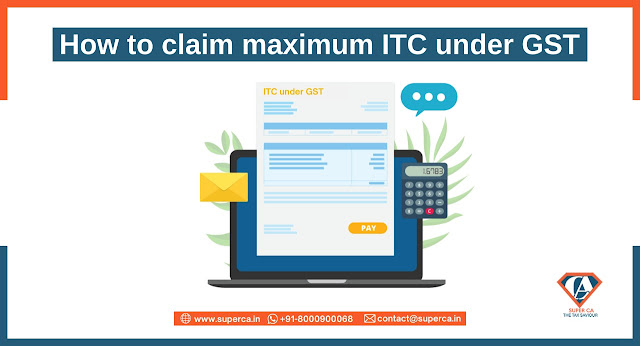How to claim maximum ITC under GST
GST taxation structure allows businesses across India to claim input credit (ITC) for the tax they paid while purchasing capital goods for their company. Input Tax Credit (ITC) simply means the tax already paid by a person at the time of purchase of some goods or services which is available as a deduction from tax payable while GST return filing.
Claiming Maximum ITC Under GST
The ITC on invoice or debit note may be availed only when the details of such invoice or debit note have been furnished by the supplier in the statement of outward supplies and such details have been communicated to the recipient of such invoice or debit note.
➤ Keeping a Regular follow-up with your dealers
Every taxpayer should follow up with their dealer on a regular basis for timely uploading their sales invoices in the GST return filing form GSTR-1. The GSTR-2A/2B of the recipient taxpayer will get auto-populated with the ITC values once the suppliers upload their sales invoices in the GST return filing form GSTR-1 return, and the recipient will be able to claim this credit in their GSTR-3B return.
➤ Identify tax payable on an Reverse Charge Mechanism basis
Under the reverse charge mechanism, tax should be paid by the recipient instead of the supplier. Thus, the expenses must be carefully analyzed by the taxpayers and inward supplies should be identified on which tax is to be paid on a reverse-charge basis. This tax should be paid timely, thus enabling ITC claims on these amounts in the next tax period.
➤ Keeping proper records of books of accounts
Taxpayers should ensure accurate records of all their sales, purchases and expenses. The Invoice copies should be maintained either in digital mode or paper-based. This will facilitate accurate ITC claims and make way for easy reconciliations while GST return filing.
➤ Consistent reconciliations
Input tax credit claimed by the person has to match the details that are specified by the supplier in the GST return filing. In case there is a mismatch the supplier and the recipient will be informed about the discrepancies once the GSTR 3B is filed.
Thus, the taxpayers should regularly check their GSTR-2B and reconcile the same at frequent intervals with the purchase register. It will in turn help in identifying defaulting suppliers and following up with them to upload the relevant invoices. Regular reconciliations help in identifying missed/mismatched/unclaimed ITC and claim the same within the prescribed time frame.
➤ Identifying debit notes raised at any subsequent time.
Taxpayers must check that a well-defined system is there for identifying debit notes raised at a later date so that any additional ITC can be claimed timely.
Time limits for claiming ITC under GST
ITC can only be claimed for tax invoices and debit notes which are less than a year old. In any other case, the last date to claim ITC is the earlier of the following:
➤ Before filing valid GST returns for the month of September following the end of the financial year applicable to that invoice. For example, for an invoice issued on June 26, 2018, ITC should be claimed by September 2019.
➤ Before
filing a relevant annual return.
Cessation
Claiming ITC in GST return filing helps you reduce the tax you have already paid on inputs and pay the balance amount. For availing of this benefit, there is a proper set of guidelines. It ensures the accountability of the suppliers to pay the required tax also prevents the overall increase in the price.

Online GST Registration | Online GST Return Filing | Online Company Registration | Online Sole Proprietorship Registration




Comments
Post a Comment